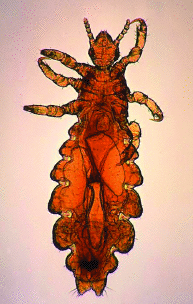| Environmental Health Perspectives
Volume 109, Number 6, June 2001
Every child is born a potential genius. Lindane is losing much of any luster it once had. The pesticide, once widely used to kill lice and a variety of pests that attack agricultural products, livestock, and trees, has slowly been eliminated from many applications since the mid-1970s. As long ago as the early 1980s, three U.S. organizations petitioned the U.S. Food and Drug Administration (FDA) to ban lindane following an FDA doctor's advisory that the pesticide caused seizures in children and test animals. In two of the latest actions, the European Commission ruled in December 2000 that member states must withdraw all authorizations for plant protection products containing lindane, and California approved legislation in September 2000 that banned lindane-based products used to treat lice and scabies. Many groups lobbied heavily to have lindane added to the list of 12 persistent organic pollutants banned by the Stockholm Convention signed in May 2001. (It could still be added to a codicil to be developed once the convention comes into force.) Lindane, known technically by synonyms such as gamma benzene hexachloride and gamma-hexachlorocyclohexane, has been in use for about 50 years. Researchers have found that the long-lasting chemical can cause liver, kidney, neurologic, and immune system damage; birth defects; cancer; and death. It may also be an endocrine disrupter. However, the FDA considers lindane an acceptable pesticide for killing lice and treating scabies when used according to the labeled instructions. Several companies still sell lindane-based lotions and shampoos. Numerous other pesticides, such as malathion, permethrin, and pyrethrins, also are used in products that target lice and scabies. To help reduce all pesticide exposures, alternative methods to detect and possibly remove lice, such as wet combing, are gaining favor in some circles.
For broader indoor and outdoor uses such as wood fumigation and agricultural pest control, the U.S. Environmental Protection Agency is in the midst of evaluating lindane as part of its reregistration process for this and many other pesticides. At present, lindane is approved only for seed treatments to fight pests such as wireworms and white grubs that attack crops such as cantaloupes, lentils, and wheat. Such plant-protection uses are no longer valid in the 15 European Union countries. On 20 December 2000, the European Commission--primarily concerned with the safety of operators exposed to the pesticide and the adverse impacts the chemical has on the environment--banned lindane for those purposes, allowing 18 months for users and producers to phase out existing stocks. But lindane may still be used for nonagricultural purposes such as household pesticides. The ban follows actions taken by several member countries and a 1999 Austrian risk assessment that concluded the chemical is a possible carcinogen with no safe exposure level. In 2000 lindane was also found by the French Institute for the Environment in a number of French waterways that are used as drinking water sources. European environmental activists support the announcement, though Helen Lynn, health coordinator for the London-based Women's Environmental Network, stated in a 13 July 2000 Friends of the Earth press release that "whilst we welcome today's decision, we are disappointed that the public will still be exposed to this dangerous chemical in the home." Water degradation and the ensuing impacts on human health and the environment were the primary drivers behind California's ban, scheduled to go into effect 1 January 2002. Research in the Los Angeles basin in 1999 revealed that, when lindane shampoos were rinsed down the drain, the pesticide readily contaminated the effluent and eventually the downstream waterways. Cutting down on lindane use through educational campaigns conducted prior to approval of the ban reduced contamination by an average of 50%, says Ann Heil, senior engineer for the Sanitation Districts of Los Angeles County. The continued use of lindane as a seed treatment shouldn't have much impact on water contamination, she adds. However, lindane pervades the food supply. In the Total Diet Study, an FDA project published in September 2000, lindane was found in dozens of foods, such as evaporated milk, ground beef, pork chops, chicken, lima beans, peanuts, popcorn, and breads. The levels of contamination aren't sufficient to cause health problems, FDA officials say. But little information exists on the interactions lindane may be having with the dozen or more other chemical contaminants typically associated with food production--for instance, benzene and chlorpyrifos--that are often found in tandem with lindane. -Bob Weinhold |
